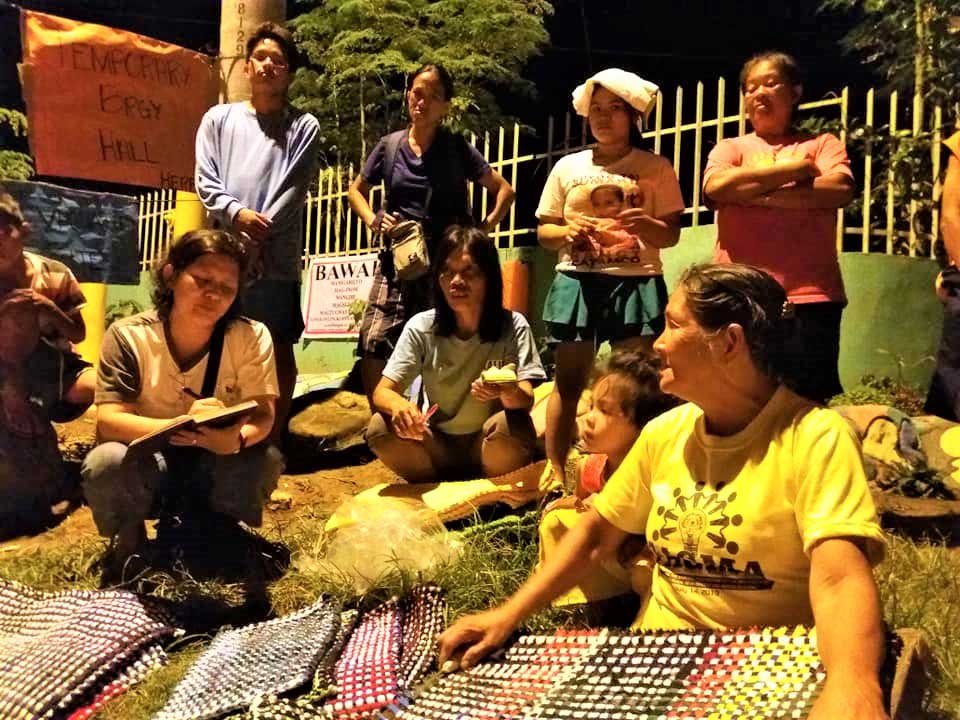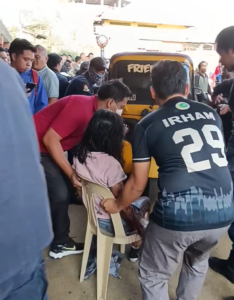“Anyone can build a house for us but only us can build our homes and communities.”
Lopito Agya, a 46 year old IP leader of the Manobo tribe of Barangay Ilomavis, City of Kidawan.

Not less than a thousand families are certain of displacement and relocation in the aftermath of the series of devastating earthquakes that rocked the provinces of Cotabato and Davao del Sur in the second half of the month of October 2019. The November 5 consolidated earthquake incident report of the Cotabato provincial DRRM Office reported a total of 33,970 families affected of which 5,263 are staying inside DSWD-designated Evacuation Camps (ECs) and other thousands outside designated ECs but still in tents or makeshift shelters. A total of 36,687 houses are damaged of which 21,324 are totally damaged. A total of 262 were injured, 7 still missing and 17 reported dead.
EcoWEB sent a Disaster Rapid Assessment Team from November 2-6, 2019 who visited most at-risk communities identified to be in the danger zones – having experienced heavy landslides or identified as landslide-prone where residents were ordered to evacuate.
A number of displaced residents expressed hope that they will be involved in the planning for emergency response to their situation and in the longer-term planning of their resettlement.

IP Experience of Conflict
Porferio Awag, 56 and wife Nelly, 50; Lopito Agya, 46 and wife Lita, were all worried when they shared their stories during an FGD outside their evacuation tent camp at the grounds of barangay Ilomavis on October 4, 2019.
The couples belong to the Manobo tribe of indigenous peoples living in Purok 7 popularly known as “Relocation” but officially named as the “Relocation Site of Lake Agco” of barangay Ilomavis in Kidapawan. They were among the worst hit by landslides resulting from the 6.5 magnitude earthquake on October 31, 2019. They were among the 113 families from the upland puroks of Ilomavis who evacuated at the barangay center after their houses were buried from rocks, boulders and mud.

“The original people here were the Manobos, our ancestors. When the Ilocanos and Visaya arrived, there were tensions and the Monobos retreated upwards to Lake Agco. After sometime, the people recognized and respected each other’s culture. When the residents decided to organize themselves into a new Barangay, they renamed the place to Ilomavis in recognition of the cultural diversity of the residents,”
Jimmy Mantawil, the barangay Chairperson in a separate interview.
Ilomavis is the acronym for the three groups with distinct cultures that settled in the area from the 1950s until the early 1970s: Ilocano, Manobo, and Visaya. It was originally part of Barangay Genatilan and was known as Upper Genatilan. Most of the Visayan settlers who first settled in the area were coming from Genatilan, Cebu who settled in the place in the 1950s.
“We used to live in the plains above Lake Agco, a body of water considered sacred by our tribe,” recalled Porferio. “The area is now the compound of the Energy Development Corporation (EDC) that operates a geothermal plant and Lake Agco is now a mountain resort visited by lowland families during weekends,” he added.
“I think I was 18 or 19 years old in the late 1980s when government officials along with soldiers came to our village informing us that we have to leave because it will be the site of a geothermal plant. I don’t understand what was that. I remembered the elders in our community, including my grandfather, held a meeting. They decided to stay in our village because we have nowhere to go. My grandfather said that we cannot go anywhere because Agco is our home. It is part of the place of Apo Sandawa,” recalled Nelly.
“I was among the older boys in our community in the mid-80’s. My father sternly warned me not to get out of our village because soldiers might suspect me of being a rebel. Our place was among those that was suspected by the military to host NPA (New Peoples Army),” Lopito Agya, 46, sadly recalled those scary days. “Our tribal elders called a meeting and told us not to be scared because our ancestors will protect us from harm. They informed us that the PNOC is going to establish a geothermal plant right in our village and we were to be relocated.”
It was in 1988 that the Philippine National Oil Company (PNOC), a government-owned energy corporation, informed the residents living around Lake Agco in Ilomavis, that the drilling for geothermal energy will commence. The Manobos, along with other tribes opposed the plan asserting that such was a desecration of their sacred grounds. The indigenous peoples found support from church and environmental groups, thus the government delayed the full implementation of the plan.
Past Displacement
“About a year after, some officials of the company came to talk with our elders. The officials told our elders that we only have two choices: receive a cash compensation package then resettle down or receive the house and lot package in the resettlement area near Lake Agco. Many of the families chose to receive the cash compensation packaged and resettled in Sayaban. My grandfather and father together with about 20 families opted to resettle near the Lake. My grandfather could not afford to live far from the Lake, his place of worship.” recalled Porferio.
“Before settling in the relocation site, we stayed in the temporary resettlement for about 2 years. We seem to adjust easily because we were resettled as a community, we were mostly relatives and our houses were closer to each other compared to our original village. Our elders negotiated hard that we shall not be removed far from the Lake. I remember that our elders even organized a picket to oppose the plan of relocating as down far from our home-village,” remembered Lita Agya, 43 years old wife of Lopito.
“From our temporary settlement, we were finally resettled again in the permanent relocation not far from Lake Agco sometime in 1993. The place was called Relocation and that was our second resettlement.” she added
“My grandfather and father chose to continue our livelihood: farming sayote (sechium edule) and abaca (musa textilis nee). Our relatives who resettled in the lower areas started cultivating more bananas, corn, and coconut to be sold in the market. We also plant bananas and corn but for our consumption only. We sold sayote and lanot (abaca fiber) to buyers who came to our village. Our sayote is known to be the best in Kidapawan, hence, buyers will come to Relocation at least once a week,” Lopito narrated.
The Earthquake Experience
On October 16, 2019, a 6.3 magnitude earthquake struck Ilomavis and other 250 barangays in at least six municipalities in Cotabato and Davao del Sur provinces causing cracks in the walls of many houses. The people were scared.
On October 29, two quakes of magnitude 6.6 and 6.1 respectively struck again in the same areas causing more cracks not only in the walls of the houses but also on the grounds. Heeding to the advice of the local government officials, families in Ilomavis started to sleep on makeshift tents at night and limited their stay in their cracked houses.
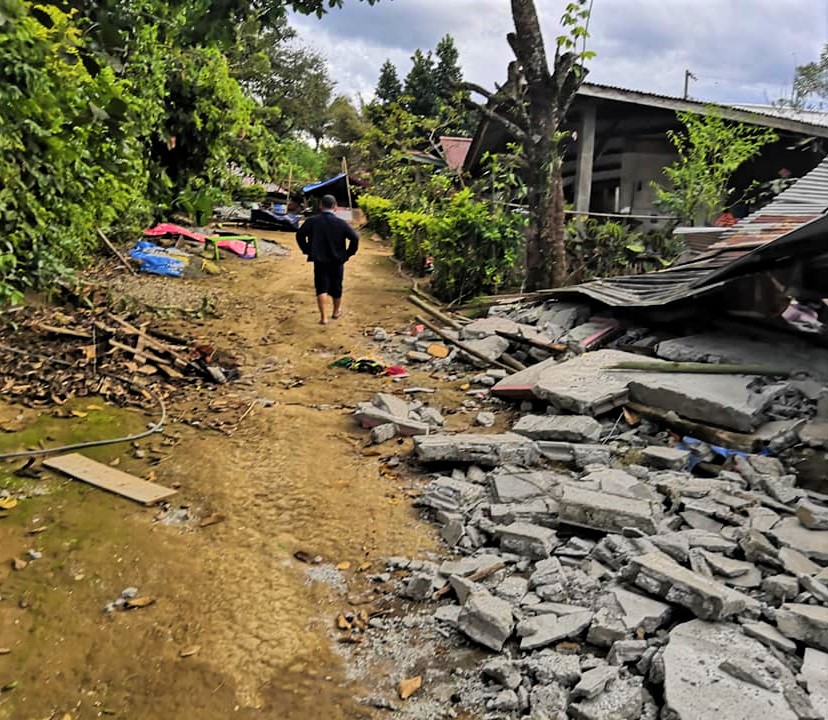



“The kitchen of our house and our toilet had big cracks and we decided to set up tents in the open ground near our auditorium. I was worried because there was a crack in our front yard,” said Lita.
“The riprap of the school area also sustained some cracks and classes were canceled the following days,” recalled Nelly.
On October 31, at about 9:15 AM, another earthquake with 6.5 magnitudes struck causing many houses that suffered cracks in the previous 3 tremors, to collapse.
“I was in our farm tending our sayote when the ground shook hoping to harvest to be able to buy some cement to repair our house that incurred damage from the quake days. The shaking was so strong I have to hold on the tree nearest to me. I ran to our house even though the ground was still shaking. I saw our kitchen and toilet detached and was buried together with the other seven houses of our neighbors,” lamented Porferio.
“I felt the tremors and heard a loud sound and, all of a sudden, the previous crack on the ground widened and part of our relocation site slide down along with our kitchen and 8 houses of our neighbors,” added Nelly.
“A few minutes before the temblor, I went inside our house to get something. Good that most of our things were already evacuated a few days before. I was already in the open ground near our auditorium when the quake occurred and was able to watch our house slide down and buried. I cried but also felt lucky that none of us was inside our house when the incident happened,” Lita narrated with teary eyes.
Immediate Evacuation
Ilomavis has a total of 1,188 families living in 7 puroks. A total of 113 families from Purok 7 (Lake Agco Relocation) and Purok 6 (Sayaban) are advised by the Local Government, pursuant to the geohazard assessment conducted by the Philippine Institute of Volcanology and Seismology (PHIVOLCS), to relocate to safer grounds as the area become very highly susceptible to landslide after the series of earthquakes. The residents were given until November 5 to salvage whatever they can from the remains of their houses.
“We are used to live with an unstable condition but our situation in the evacuation center is more difficult,” lamented Lita Agya. “We have to share with the other two families in our makeshift tent. We need more trapal (plastic sheet) and lumber so that each family will have its own shanty.”
“The toilets in the barangay hall and auditorium are not enough. We have to queue and wait. The water supply is not also sufficient. Some of us have to go to the river to take a bath but the river here in the lowland is not as clean as those in the mountains. It’s good that the Red Cross provided drinking water.”
“We depend on the food distributed by the government and those who have kind hearts. We are thankful for all the assistance but we know these will not last for long,” said Lopito. “We need to have our own income so that we can buy our own food. We are dirt poor but we do not depend on others for our food.” she added.
Traumatized
Not far from where we talk, two men were trying to set up their tents. They were erecting a bamboo post but it fell because it was not tied tightly causing a loud thud that jolted almost all people around. At least two women shouted at the men. One lambasted them for “making my spirit jumps out of my body.” Another for scaring her children.
“People are still very nervous, especially the women and children. Many women were inside their house doing their household chores when the October 31 earthquake struck. Some of their children were helping them. That is why many of those injured were women and children. Most of the men were in their farms and other works.” explained Porferio.
“We really need help in lowering our anxiety but it seems that no agency or NGO is providing medicine for this kind of problem,” Nelly commented jokingly. “If there is one, I’m sure many will queue for treatment.”
The need for trauma healing is expressed by both men and women in all the barangays visited by the EcoWEB Disaster Assessment Team. Social workers of the government also confirmed the need but they expressed their difficulty to respond to the need because they have limited skilled staff to conduct the psycho-social debriefing. The available staff could only attend to those having severe post-traumatic symptoms. DepEd personnel and teachers also expressed the same need for so many children traumatized.
Hopes for Better Participation in Planning for Relocation
The City Mayor of Kidapawan ordered for the immediate evacuation of the residents of Purok 6 and 7 of Ilomavis. They were advised to salvage whatever they can as the entry to the place will be restricted. The Mayors of other municipalities also ordered the total evacuation of badly hit barangays.
“This would be my third relocation,” lamented Lopito Agya, “the first two was when we were displaced by the PNOC operations. I do not want to live at the Relocation anymore but my livelihood depends on my sayote and abaca farm there. These are the only crops I am very familiar and with no problem for market. Can I find a similar place that grow very good quality sayote?”

“The local government said that they will allow us to continue farming in Purok 7 but we have to be relocated somewhere here at the lower part of the barangay. The fare in going to Purok 7 is 30 pesos for one way and with return, 60 pesos a day. If I work for 6 straight days, that means P360 a week and P1,440 a month! The amount is almost half of my monthly income from my sayote farm! My family could not survive with what remain! Can the government give us free transport?” Porferio asked with a smile.
“Relocation could make us safe from earthquake but not from hunger. A livelihood that we know can best secure us from hunger. Farming is the only livelihood we know. We are already too old to be employed in the city. We have no lands to farm in the relocation site. How long will the government provide us rice? We cannot survive by relief goods alone,” said Nelly.
“Anybody could build a house for us but only us can build our homes and communities,” Lopito, Nelly’s husband, added.
In barangay Kinarum, Magpet, also in the foot of Mt. Apo, residents were also scared to go back to their farms because of ground cracks. Most of them evacuated in the barangay center. Some are even threatened to be displaced from their ancestral domain.
“We started claiming our ancestral domain in Sitio Angelo, in Barangay Kinarum but we are advised to leave our community inside our domain after the earthquake,” lamented Manuel Lacia, 65, the head-claimant of their 1,600 hectare ancestral domain. “What’s the use of claiming our land when we cannot live there?”
“Earthquakes happened during the time of our ancestors but they survived that’s why we are here. Indeed, it’s very scary but I believe it will stop. I have not yet decided to relocate as advised,” said Aurelio Lacia, 62, and a member of the Council of Elders of the IPs in Kinarum. “If relocated, we should be consulted because it is not the government that will build our home and community, it is us. The plan to relocate us must consider our customs and traditions. If not, many of us will simply move to safer grounds of our choice.”


The fears of the Awag and Agya families of Ilomavis in Kidapawan City and Lacia family of Kinarum in Magpet municipality are also echoed by indigenous peoples (IP) of various tribes living mostly in the rock/landslide-prone areas of not less than 25 barangays ordered to be fully and partly evacuated by the local government units of the municipalities of Makilala, Tulunan, Magsaysay and Magpet, and the City of Kidapawan upon the advice of PHIVOLCS and the Mines and Geosciences Bureau (MGB). Most of them expressed their desire to participate in choosing and planning for their relocation sites.
Livelihood Displacement
“We have survived without money since the October 16 quake, mainly relied on relief goods for survival”
quoted from Rircardo Masanlo, 63, from Purok 6, Malawanit, Magsaysay where a mother and her baby died whose house was covered by a landslide in the evening of October 16.

The father and another child of theirs were rescued by the neighbors despite the shaking and darkness of the night, narrated by their IP Mandatory Representative Rolando Lasanda.
Losing their livelihoods is among the leading fears of those who are affected especially those who need to relocate. Many have to overcome their fears in order to recover their livelihood. Others really face a total loss of the sources like farms and stores.
“I was tapping the rubber trees when the earthquake occurred (referring to the October 31 quake). I was thrown to the ground thus I have to hug the rubber tree, tighter than my hug for my wife,” jokingly recalled Dennis Descallar. “Since then I did not return to the farm, the rubber saps are now over-dried or damaged.”
Ricardo Masanlo, 63, also lamented how difficult life has been since they could not harvest their coconut and other crops anymore in their landslide affected community in Purok 6, Malawanit, Magsaysay, Davao del Sur.
“We have survived without money since October 16 quake, mainly relied on relief goods for survival’, Ricardo sighed. The lamentation was also shared by a local official who narrated how scared he was when the ground heavily shook while harvesting his coconut on October 31. The harvest was just left behind to save his life.
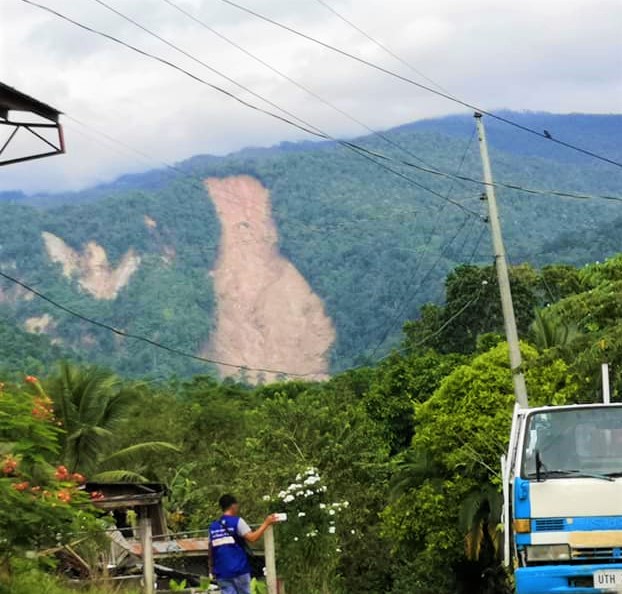
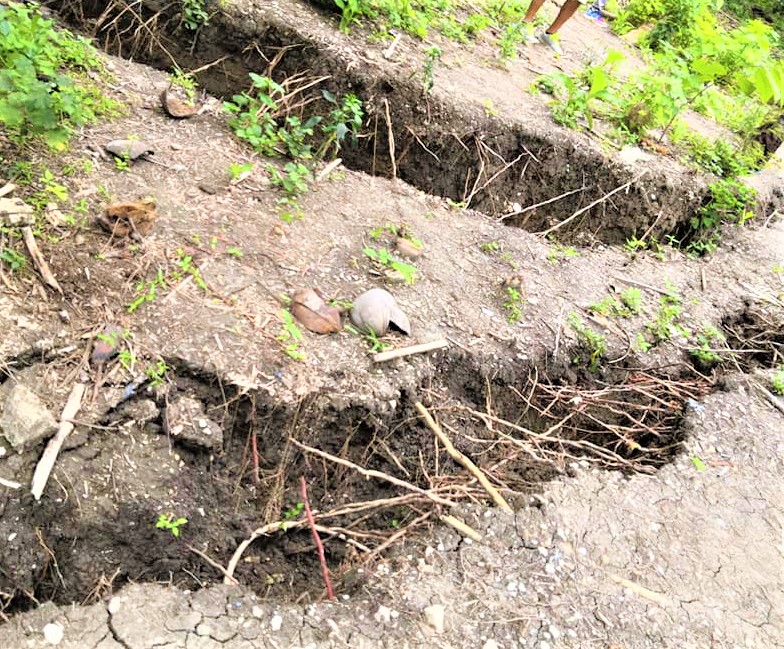
“I also stopped collecting tahite grass for making brooms because I’m scared that the boulders above our farm will fall if there will be another tremor,” said Marlyn, Dennis wife. “My husband earns 35% of the income of the rubber. The owner of the farm allows us to plant tahite grass on the sides of the rubber farm. The owner does not ask for share from the income of the brooms we make from tahite. We both lost our income.”
“I am scared to go back to my farm because the rocks might fall anytime but I need to harvest my sayote so that my family could have some cash. My worry is where to sell them,” commented Lopito. “I don’t think buyers will come here now as they used to do because they are scared of the earthquakes. If I deliver the sayote to the city, I need money for transport. I have none.”
“We have no work, hence no income since October 16 when Dole-Stanfilco stopped operation,” lamented Arsenio Labado, a Kagawad of Barangay Buenavida who works with the banana plantations owned or contracted by Dole-Stanfilco. The same story for Thelma Cagadas, 44, of San Isidro, Malasila in the municipality of Makilala who prided to be regular being the priority for hiring by DOLE when there is work but lost her source of income since October 16 quake. “I lost my P300 a day income as worker in the packing manufacturing of DOLE Stanfilco,” lamented Thelma. For non-regular they are earning P290 per day, she said.
“It’s half-a-month now that we do not have income and we relied on relief goods. We have no more homes we have no income too!” Thelma lost her 70 years old mother during the October 31 quake when their house collapsed. The wake was made inside a makeshift tent in the basketball court within their devastated community during the interview.
In Need of Assistance
“We still have our farms but we need support to repair our house. We also need assistance but we are told that we cannot access government support because we are not staying in evacuation centers.”
explained Helen Bernales, a Kagawad of Barangay New Caridad, Tulunan, Cotabato.
“Our house is still standing but its unlivable because of the cracks. We decided to set up a temporary shelter outside our house. We asked support from the DSWD but we were told to wait because their priority are those in the evacuation centers.” she added.
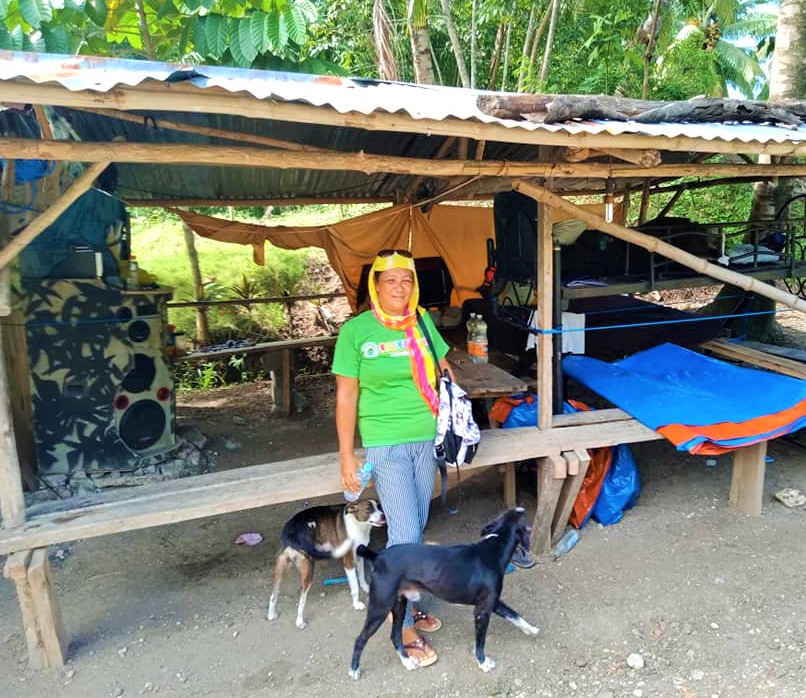
The same lamentation was expressed by Datu Brigido Baroro, the IP Mandatory Representative to Barangay Ilomavis and among the community leaders who initiated the setting-up of community-managed makeshift tents comprising 7 tent camps hosting 138 affected families.
“We decided to set-up our own temporary campsites because the DSWD designated ECs are congested and lack facilities,” said Datu Brigido. “We argued with DSWD staff who said they could not provide us food packs and enlist us because we are staying outside the designated ECs. We hope we are allowed to identify safer grounds and safer for our children. We wish to call for support,” he further narrated which was corroborated by a barangay official who was present during the talk.
The concerns of the Descallar couple of Kinarum, Magpet and that of Arsenio and Thelma of Buenavida, Makilala were also echoed by thousands of internally displaced families now staying in government-designated evacuation centers. The worries of Helen and Datu Brigido are also echoed by many who opted to establish their temporary shelter just within their identified safer grounds within their communities and near their damaged homes so that they could still do their farming, caring of their farm animals and for could be safer for their children.
Having lost their daily income from jobs with DOLE Stanfilco banana plantation, the Perez Rag Wavers Association of women have seen the possibility of gaining income from their rag making. “Apart from the more than 30 active women members of the association, other women in the community are also producing rags and sell to our association,” said Josephine Nagera, a leader of the association, “however, we lost the market since the quake hit our area,” she further narrated. Amalia Ganzo, 48 years old, a mother of 6 children, a member of the women association, proudly narrated that she and her husband can finish 10 rags a day that could earn them about P200 for a day’s hard work. Amalia and Josephine with other women around during the evening discussion in their evacuation site just hoped that they can be assisted of their rag making livelihoods as they await their fate as to their possible relocation. “We don’t know our future, we are also living in a land we don’t own, we just rent our home lots,” said one old lady in the group. Barangay Perez in Kidapawan City is among the hardest hit of the earthquake swarm.
